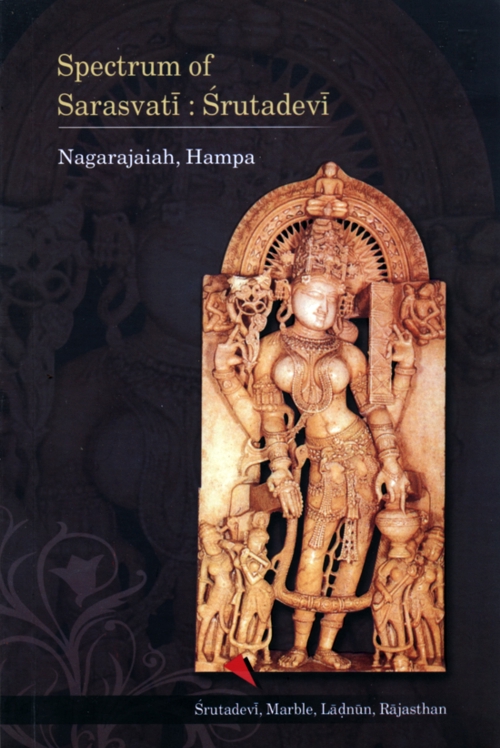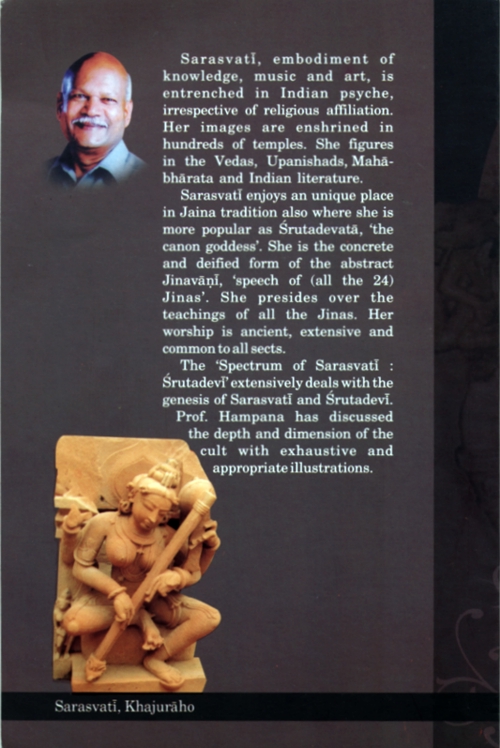Sarasvatī, embodiment of knowledge, music and art, is entrenched in Indian psyche, irrespective of religious affiliation. Her images are enshrined in hundreds of temples. She figures in the Vedas, Upanishads, Mahābhārata and Indian literature.
Sarasvatī enjoys an unique place in Jaina tradition also where she is more popular as Srutadevatā, 'the canon goddess'. She is the concrete and deified form of the abstract Jinavānī, 'speech of (all the 24) Jinas'. She presides over the teachings of all the Jinas. Her worship is ancient, extensive and common to all sects.
The 'Spectrum of Sarasvatī: Śrutadevī' extensively deals with the genesis of Sarasvatī and Srutadevī. Prof. Hampana has discussed the depth and dimension of the cult with exhaustive and appropriate illustrations.
Spectrum of Sarasvati: Srutadevi
© by author:
Prof. Nagarajaiah, Hampa:
First Impression
2009
Publisher
National Institute of Prakrit Studies and Research Bahubali Prakrit Vidyapith, Shree Dhavaļa Teertharh, Shravanabeļagoļa-573135, India
Pages
112 pages
Price
Rs. 175/- £15 $20
Paper
Art Paper 100 gsm
Cover Page
Manjunath S.
Cover Photo
Srutadevī, Lādnūn, Rājasthan
DTP
Friends Com-Tech, Bangalore-18
Printed at
svan printers CD +91-80-2674 2233
With gratitude unbound
Dedicated to
E.J. Brill
Leiden, Netherlands,
for helping the authors working in the field of Oriental and Indological Studies through its extraordinary publications
Publisher's Note
The 'Spectrum of Sarasvatī: Srutadevī, authored by Prof. Dr. Hampa. Nagarajaiah, has fulfilled a desideratum pending for a long time. The concept of Śrutadevī is unique to Jainism. Jainism has given prominent place to Sruta, knowledge. Therefore Śrutadevī always holds book in her hand, which represents canonical knowledge. The beads in the rosary that the goddess holds also represent the mantras. Dr. Hampana is a renowned scholar of Kannada, Prakrit and Sanskrit literature in addition to his mastery in Epigraphy and Iconography. His published books cover a wide range of topics. He has exhaustively dealt and discussed the rarity of Srutadevī, and the illustrations are a rare collection.
His Holiness Svasti Shri Chārukīrti Bhattāraka Pattācārya Mahāsvāmiji, who is the guiding spirit behind all our literary activities, is pleased to publish this monograph. We thank the author for providing us an opportunity to publish this important book.
Prof. Prem Suman Jain
Director
National Institute of Prakrit Studies and Research Bahubali Prakrit Vidyapith, Shree Dhavalateertham
Shravanabelagola
Foreword
For more than two millennia Jains have integrated female divinities into their religious practice as protectresses and emblems of their ancient tradition to such an extent that anybody only slightly familiar with Jainism's art or architecture would still be aware of their ubiquitous presence in the devotional life of renunciants and laypeople, whether Svetāmbara or Digambara. Regrettably the first western scholars of Jainism, whose familiarity with Jainism was largely derived from texts, either ignored this vital component of the religion or attributed it exclusively to borrowing and processes of Hinduisation, which supposedly became more pronounced through the medieval period. This misapprehension was decisively corrected by John Cort whose significant paper 'Medieval Jaina Goddess Traditions' (Numen vol. 34 1987) makes clear how the personalities of the goddesses found within Jainism, while often overlapping in some respects with their Hindu counterparts, are distinctively Jain in their benevolence and vegetarianism, reflecting the transformative influence of an ethic of non-violence.
However, despite this timely reminder, it must be admitted that few studies of individual Jain goddesses have yet been undertaken and those interested in this aspect of Jainism have generally been compelled to research laboriously in disparate and often obscure art historical publications or to sift through large numbers of hymns in Sanskrit, Prakrit, Gujarati, Kannada and other languages. We must therefore congratulate Professor Nagarajaiah who in a relatively short span has assembled here a cornucopia of apposite texts and choice illustrations relating to Sarasvati, perhaps the most attractive of Jainism's many goddesses, and described with impressive learning the origin and dissemination of her iconography and worship.
Sarasvati is of course a pan-Indian deity who was worshipped by Hindus, Buddhist and Jains. Originally a riverine goddess, she is representative of the sacral association of water and womanhood which has always played a significant part in informing basic Indian perspectives on female divinity. Jainism is not preoccupied with Sarasvatī's identity with the river of the same name, but rather from near the very beginning of its artistic tradition has highlighted her role as goddess of culture and wisdom and also protectress of the scriptures. A myriad reproductions in painting and sculpture of Sarasvatī, typically depicted holding book or vīnā and seated on a lotus or a swan, testify to her longstanding hold on the Jain imagination. Professor Nagarajaiah's homage to her in this elegant little volume will fascinate and delight scholars and general readers alike.
03.03.09
Paul Dundas
Reader in Sanskrit University of Edinburgh Scotland, U.K.
About the Author
Prof. Nagarajaiah, Hampa, one of the major litterateurs of Karnātaka, has authored more than 70 books in Kannada and English. His writings, spread over four decades, cover a wide range of topics embracing different disciplines and fieldas of research. Some of his books have been translated into English, Hindi, Marathi, Tamil, Tulu, Gujarati, Rajasthani and Telugu. He has taught under-graduate and postgraduate classes for over 37 years. He has served Kannada Sāhitya Parishat, the premier literary Institute in Karnātaka, as General Secretary (8 yrs) as well as President (8 yrs). With 'hampanā' as his nom de plume, he is a recipient of a number of State and National Awards. Contemporary literati have honoured him with six festschrifts. Dr. Nagarajaiah has presented papers at the National and International Congresses and Symposia and delivered Endowment and Foundation Lectures in various Universities. His contribution to the study of Jainology, in particular, is seminal and significant.


